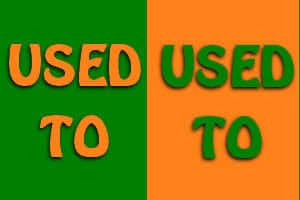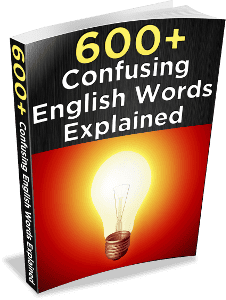
 This is a free sample from the e-book 600+ Confusing English Words Explained. It will help clear up your doubts about how to use English words correctly, so that you can speak and write more confidently. Click here for more information!
This is a free sample from the e-book 600+ Confusing English Words Explained. It will help clear up your doubts about how to use English words correctly, so that you can speak and write more confidently. Click here for more information!Many English learners confuse the two forms of used to. Read this lesson to understand the difference!
used to = accustomed to
The first meaning of used to is “accustomed to” – when something was strange or different for you in the past, but now you think it’s normal:
- When I first moved to Korea, I didn’t like the food – but now I’m used to it.
- We‘re used to waking up early – we do it every day.
- My 4-year-old son cried on the first day of school; he wasn’t used to being away from his mother the whole day.
- It took me a long time to get used to driving on the right side of the road after I moved from New York to London.
- So, you’ve lived in Finland for 5 years – are you used to the cold weather yet?
Before this form of used to, we use the verbs BE and GET – “be” to describe the state of being accustomed to something, and “get” to describe the process of becoming accustomed to something.
After this form of used to, we use a noun or the -ing form.
used to / didn’t use to = something you did repeatedly in the past, but not now
The second meaning of used to is to describe actions you did repeatedly in the past, but that you don’t do now:
- When I was a child, I used to go to the beach with my grandparents.
- He used to play tennis, but he stopped a few years ago.
- She didn’t use to like vegetables, but now she eats them frequently.
- They didn’t use to come to church, but now they’re among the most dedicated members.
- Did you use to drink a lot in your college years?
After this form of used to, we use the infinitive of the verb.
Quiz: Two forms of USED TO
Choose the best form to complete each sentence. Good luck!
Start
Congratulations - you have completed Quiz: Two forms of USED TO.
You scored %%SCORE%% out of %%TOTAL%%.
Your performance has been rated as %%RATING%%
Your answers are highlighted below.
Question 1 |
I had just ____________ the database program at work when they changed it. Now I'll have to learn a completely new system.
A | used to |
B | being used to |
C | gotten used to |
Question 2 |
Has she taken voice lessons? She ____________ so well.
A | got used to singing |
B | isn't used to singing |
C | didn't use to sing |
Question 3 |
I just moved to a tiny apartment and I __________ so little space.
A | am used to have |
B | didn't use to have |
C | 'm not used to having |
Question 4 |
Now my father is bald, but he _________ black hair.
A | was used to have |
B | used to have |
C | is used to having |
Question 5 |
Before the invention of e-mail, people __________ wait days or weeks for a reply to a letter.
A | got used to |
B | were used to |
C | used to |
Question 6 |
My brother and I __________ a lot when we were younger, but now we get along fine.
A | used to fight |
B | didn't use to fight |
C | are used to fighting |
Question 7 |
After getting married and moving in together, you need to ____________ all the annoying habits of your husband or wife.
A | come used to |
B | get used to |
C | be used to |
Question 8 |
After changing diapers for six children over the course of twelve years, she's __________ by now!
A | not used to it |
B | used to it |
C | get used to it |
Question 9 |
I _________ business meetings being so formal - in my country, we're a little more laid-back (=relaxed).
A | don't used to |
B | 'm not used to |
C | didn't get used to |
Question 10 |
Carla __________ her entire salary on new clothes and shoes, but now she's more disciplined with her money.
A | is used to spending |
B | used to spend |
C | didn't use to spend |
Once you are finished, click the button below. Any items you have not completed will be marked incorrect.
Get Results
There are 10 questions to complete.
You have completed
questions
question
Your score is
Correct
Wrong
Partial-Credit
You have not finished your quiz. If you leave this page, your progress will be lost.
Correct Answer
You Selected
Not Attempted
Final Score on Quiz
Attempted Questions Correct
Attempted Questions Wrong
Questions Not Attempted
Total Questions on Quiz
Question Details
Results
Date
Score
Hint
Time allowed
minutes
seconds
Time used
Answer Choice(s) Selected
Question Text
All done
Need more practice!
Keep trying!
Not bad!
Good work!
Perfect!









